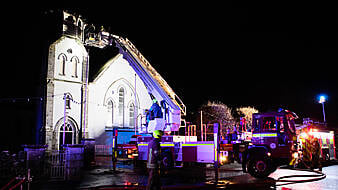Eamon Butterly has told a jury at the Dublin District Coroner’s Court that he did not find out what surface spread of flame rating meant before carpet tiles were used on the walls of the nightclub.
The inquest heard that,during a 1981 inquiry, evidence was given that the carpet tiles were the most substantial contributor to the spread of the fire.
It heard that a surface spread of flame test was carried out and these tiles were found to be of Class 4 rating, not Class 1 as required.
The Stardust manager is continuing giving his evidence in the Pillar Room of the Rotunda Hospital at the inquest into the blaze that killed 48 people when it swept through the Stardust nightclub in the early hours of February 14th 1981.
Michael O’Higgins SC, representing a number of the families of the victims, referred to a letter written to the original architect of the Stardust outlining a requirement of Dublin Corporation's chief fire officer that all internal wall and ceiling linings have a minimum Class 1 surface spread of flame rating.
“The conditions actually specified that before a sod of soil was turned, you had to sit down with the chief fire officer,” said Mr O’Higgins.
“The applicant of the planning permission had to, my father,” replied Mr Butterly.
“It was a family business and you were a person who was supervising the building of these premises,” said Mr O’Higgins, going on to say that Mr Butterly did not sit down with the chief fire officer before building commenced.
Mr O’Higgins said that the original architect gave a statement saying he was engaged by Mr Butterly’s father and applications were made until finally permission was granted in October 1976. Subsequently, the architect said that when they failed to reach agreement on his fees, he parted company with Mr Butterly’s father. Subsequently, Harold Gardner replaced the original architect.
“I take it you knew Mr Gardner did not have any professional education in the sense of any degree?” asked Mr O’Higgins.
“As far as I was concerned about Mr Gardner, he was quite capable of doing the job,” said Mr Butterly.
“You didn’t have an architect supervising the project. He’s not a qualified architect, he was not employed in the way an architect would be employed to supervise a project,” said Mr O’Higgins.
“He was not an architect and still he was dealing with the Dublin Corporation as an architect, they accepted him. I didn’t know what his actual qualifications were, but he did his job,” said Mr Butterly.
Concerning the carpet tiles placed on the walls of the Stardust, Mr O’Higgins referred to original statements made by Mr Butterly concerning planning conditions about the surface spread of flame in which he said: “I did not know what Class 1 surface spread of flame rating meant.” In the statement, Mr Butterly also said he could not recall if he brought this to Mr Gardner’s attention.
“The whole point of having a professional advising you is there are correspondence and records, but you don’t even know if you gave him any of these letters,” said Mr O’Higgins.
“I can’t remember now anyway,” said Mr Butterly.
“Why didn’t you find out what surface spread of flame meant?” asked Mr O’Higgins.
“I expected that if the Dublin Corporation were happy for us to put them up on the walls, I’d be happy,” replied Mr O’Higgins.







